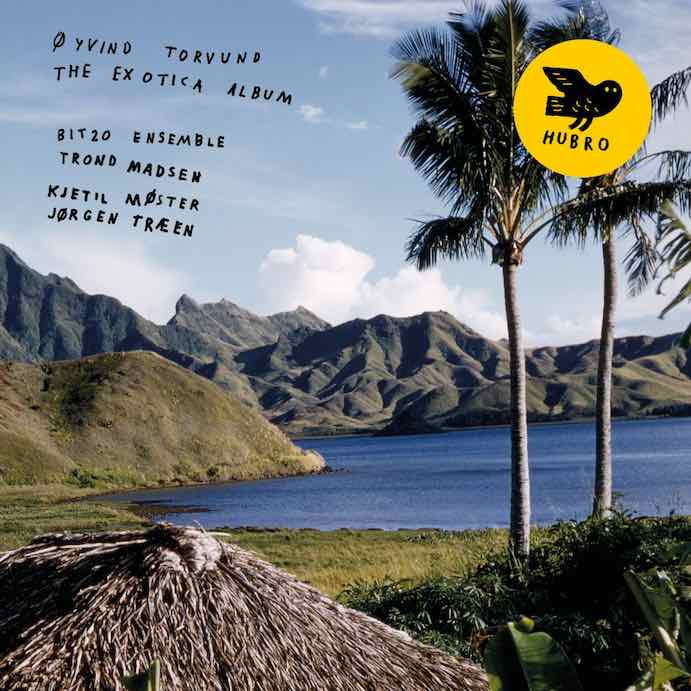Norwegian composer Øyvind Torvund’s recent release on Hubro Music, The Exotica Album, is a dreamlike retrospective on the eponymous post-war fad genre, expertly performed by Norway’s BIT20 Ensemble with guest soloists Kjetil Møster and Jørgen Træen (sax & electronics and modular synth & noise, respectively). The extended multi-movement work crafts a narrative from references to lounge music–exotica’s more palatable moniker–and aggressive gestural textures, a surprisingly cohesive album for its expansive sonic language. It’s a masterclass in style-specific orchestration updated for contemporary ears; however, it updates a genre whose existence is rooted in colonialism and mass–consumerism and, while the work is carefully considered, it comes off as fairly uncritical of its lineage.
The album opens with “Ritual 1,” optimistic whistling interspersed with electronic blips and trilling flute interjections, a sparse texture that gives way to lush melodic strings and a lumbering percussive background on “Starry Night.” From this moment onward, we are firmly in a three-dimensional space, “going up a river in a canoe and suddenly discovering these abstract installations,” in the words of the composer. The soundscape is so remarkably familiar that it’s easy to miss the idiosyncratic details: a vibraphone faintly expands the harmony; the harp and piano exchange soft arpeggios while woodwinds fly up and down in knotty chromatic lines; Møster and Træen supplement with delicately-placed filter sweeps and synthesized pops where exotica-of-old would have directly sampled animal sounds. The harmonic cushion disperses for a moment, and we are left with a microtonal chamber ensemble of flute, piano, and electronics. They flit around the rest of the ensemble, eventually giving way to an expansive saxophone solo.
Øyvind Torvund–Photo by Dimitri Djuric
The Exotica Album shifts between these modernist and lounge worlds with ease. “Waking Up Again” utilizes a dense noise and electronics texture without losing its connection to the idyllic sounds prior, even though any objective analysis would suggest you’re studying up on early avant-garde synthesis. “Rainforest Morning” displays a superbly blended texture of downward dripping between plucked strings, percussion, and electronics, while the abrasive honking of “Jungle Alarms” brushes an industrial gloss over the narrative. Moments that seem straight out of the ‘50s are tinged with dissonant fractures; the birdlike trumpet and percussion duet of “Rainbow Crystal” is an illustrative example, or the temporally loose piano comping on the closing track. BIT20 expertly navigates their different narrative roles throughout the work, easily guiding the listener through the half-hour experience.
Torvund’s deft orchestration and clever troping threads instruments and ideas together seamlessly, in an impressive kaleidoscope of melodic/timbral balance. Yet, there is a degree to which the album does not stand up to repeated listenings; though stuffed with thoughtful detail, it doesn’t necessarily move beyond this studied blend of two unrelated mid-century aesthetics. It remains the case, however, that Torvund is a master of warping the familiar, of twisting pastiche into something uncannily nostalgic, a skill of construction displayed throughout his oeuvre and crystallized on The Exotica Album.
BIT20 Ensemble
So why does it feel so uncomfortable? Well, because exotica as a genre was constructed by white men for a new demographic of white Americans who craved escapism, and thus readily consumed a style whose nominal foundation was a lazy sonic representation of the “Other.” The presentation of The Exotica Album certainly relies on these old clichés; the album cover is a photo of Rapa Iti, an island in French Polynesia, and the liner notes include a short narrative by Rob Young that reads like a 21st-century Heart of Darkness, for better and for worse.
Yet it’s almost hard to accuse exotica of appropriation because it so barely incorporates actual non-Western aesthetics past the cringey titles; for all its problematic cultural underpinnings, exotica was something sonically novel. We may dismiss it today as kitschy easy listening, but its fans ranged from post-war white suburbanites to famous bandleader Sun Ra, who admired the yearning to explore embodied by the genre and emulated this sentiment in his own work. (Sun Ra himself has an album titled Exotica.) Bizarrely wrapped up in the imperialist Othering of exotica was a totally new style.
To my ears, Torvund’s project takes a position similar to Sun Ra: adopting a distinct genre to his own unique language and interests. In the process, he has produced an extraordinarily well-crafted work that can’t help but tread the programmatic ground its aesthetic predecessors paved (though it certainly does little to distance itself). It would be irresponsible to dismiss the talent on display on The Exotica Album, but it is no less irresponsible to ignore the problematic history of this style and its relationship to Western colonial (mis)understandings of the world. Entertainment and critique need not remain mutually exclusive endeavors.

